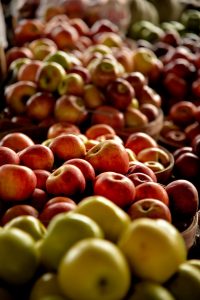Is There Fat in Fruits and Nuts, and How Much?

When it comes to your diet, fats aren’t necessarily bad. A healthy diet can contain up to 35 percent of total calories per day from fat, according to the USDA’s dietary guidelines. And while most people associate fat with junk food, many “healthy” foods contain fats as well – including fruits and nuts.
Why is there fat in fruits and nuts?
The fat in fruits and nuts is used as an energy source and for protection.
“Plants are comprised of cells like every other organism. Cells all have a membrane and enzymes to make fatty acids and other types of fats that are needed for the structure of the membrane and also for energy storage,” said Jonathan Allen, professor of food, bioprocessing and nutrition sciences at NC State.
Most fruits are either seeds or contain seeds. As that seed grows into a tree, it uses material stored in the fruit or nut as an energy source until it can use its leaves to get energy from the sun. But not all fruits use fat primarily to store energy. Some fruits, like apples, limit their fat production and instead use it as a waxy coating to keep the inside moist. So where do apples get their energy? Apple seeds are surrounded by carbohydrates and organic acids that can supply energy for growth.

Why do some diets suggest more nuts than others?
The fats that are in nuts contain more calories per unit of mass than carbohydrates.
“When comparing a dried raisin to a nut of the same weight, the fat in the nuts has 9 calories per gram and the carbohydrates in the raisin have 4 calories per gram,” Allen said.
Fresh fruit is 90 percent water, so some diets suggest more fruits in order to get the nutrients and water from the fruit.
However, nuts contain a large portion of protein and fiber, which is why some diets are more nut-focused than others.
Many new studies favor the nutritional quality of nuts, because they are good sources of protein, fiber and fatty acids.
“Most people’s diets contain more Omega 6 fatty acids relative to their need for Omega-3 fatty acids, and most nuts contribute to that trend,” Allen said.
When it comes to making food choices, you don’t necessarily need to focus on the fat content in nuts. Instead, you might want to pay more attention to total calories.
“You can add a lot of calories by overeating great-tasting nuts – and the food processing industries keep working to make them taste better,” Allen said.
How does fat in nuts compare to, say, a potato?
A potato actually doesn’t contain much fat. A potato is mostly water and carbohydrates with a miniscule amount of fat, Allen said. It might taste better if you add butter or sour cream (saturated fats) to a baked potato, or cook French fries in peanut oil (unsaturated fat). Also, a serving size of peanuts is 1 ounce and a serving size of a small potato is about 3 ounces. He added it is pretty easy to eat more than a single 1-ounce serving of nuts in one sitting. “And, some of those nuts can contain as much as 70 percent fat, so that could provide a lot of calories,” he said.
Which nuts contain the least amount of fat?
The nuts with the lowest fat content in the USDA database were chestnuts at 0.5 to 2 percent fat (chestnuts from different geographical regions have different fat contents). Most of our common nuts are 40 to 70 percent fat.
Which fruits contain the least amount of fat?
The fruits with the lowest fat content in the USDA database have about 0.1 percent fat, including casaba melon, pineapple, oranges and apples. On the high end, avocado and olives have 10 to 15 percent fat, Allen said.
- Categories:


